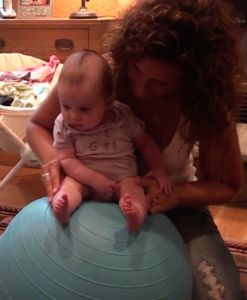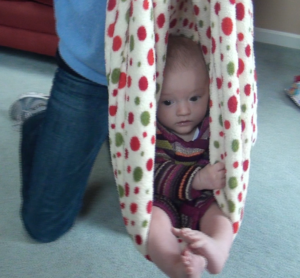
As we talked about at three months, babies appear to be born with essentially no sense of balance, but it develops significantly over the first year. Balance is not just necessary for standing and walking. Crawling, rolling over, sitting, reaching for toys require balance; the simple task of holding our head at midline requires balance.
Tummy-time provides a great opportunity for your baby to lift her head and begin to develop the balance, strength, and coordination skills that future milestones will build on. Usually by three to four months babies are holding their heads up to 90 degrees while on their tummies and starting to push up on their forearms and lift their chest off the floor by four to five months of age. As they turn their heads side to side and take in their world, their sense of balance is assisting other important skills such as vision, perception, core strength, coordination, and motor skills, to name a few. It is incredible how many skills and milestones build on the sense of balance.
The balance centers of the brain, the parts of the brain that are responsible for and perceive balance is also known as the vestibular system. It addition to sensing proprioception (knowing where our body parts are in space), the vestibular system also senses movement, vibration, bouncing, jiggling, and swinging. Most of these motions are commonly used to calm a fussy baby and scientists believe that the connection to the vestibular system is why bouncing and middle other repetitive movements are calming to the baby. Because the movement itself helps to improve your baby’s sense of balance and her ability to perceive movement, it provides a sense of security. Bouncing and jiggling are also soothing because they are done to the whole body, as opposed to just patting the baby’s back, so it is more calming to her entire system. Any activity or movement that causes the baby to experience these sensations throughout their whole system are very stimulating to their vestibular system. Vibrating chairs, swings, being pushed in a stroller, riding in the car in a car seat all contribute to a healthy sense of balance. Even though these seats, carriers and swings contribute to balance, babies should only be restrained in a seat or carrier when necessary, such as when they are in the car or stroller, or you just have to get dinner made with two hands!
Some things you can do to help build your baby’s sense of balance and enhance their vestibular system are:
- Supervised tummy time (as mentioned above). This could be on the floor, a blanket, on the bed, across your lap, or your baby could lie on your chest while you lie on your back. Talk to your baby, encouraging them to lift their head and make eye contact with you.
- Provide movement by holding your baby and bouncing, rocking, or swinging her side to side.
- Lie your baby on the floor on a large blanket, then pick up the four edges of the blanket so that it forms a hammock around your baby. Pick him up and swing him back and forth and side to side, slowly. Maintain eye contact through the top of the blanket so that he feels safe.

- Once your baby is able to hold her head up, hold her vertically in a baby carrier that you strap to your chest while you are out walking or doing house-hold chores so that she gets used to being upright and processing the world from that position.
- Use a large beach ball or bolster pillow and place you baby on his stomach or back. Roll the ball side to side and front to back, allowing your baby to feel the change in gravitational pull on his body. As he gets closer to walking, encourage him to bear weight through his arms as you roll him forward and through his legs as you roll him back. It will not only help build core strength, but it will start to teach him the protection reflex which is so important to protect his face if he falls forward while walking.
References:
Acredolo, L., Goodwyn, S. (2000). Baby Minds: Brain Building Games Your Baby Will Love. Bantam Books.
Aamodt, S. & Wang, S. (2011). Welcome to Your Child’s Brain: How the Mind Grows from Conception to College. Bloomsbury, NY.
Healy, J. (1994). Your Child’s Growing Mind. A practical Guide to Brain Development and Learning From Birth to Adolescence. Doubleday.
Kliegman, R., Marcdante, K., Jenson, H. & Behrman, R. (2006). Essentials of Pediatrics, Fifth Edition. Elsevier Saunders.

